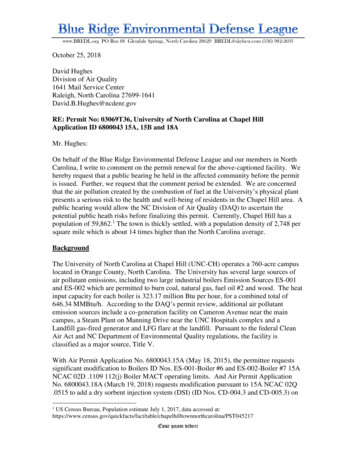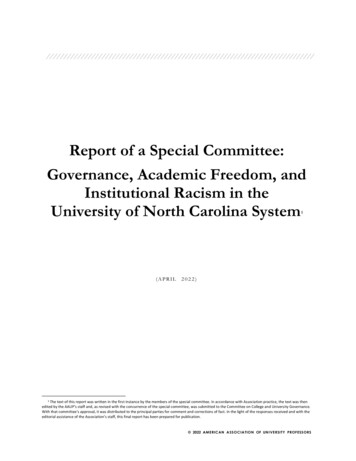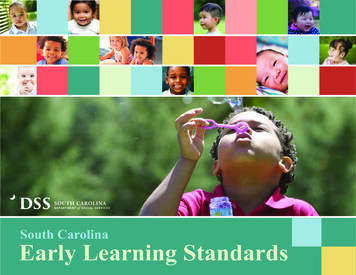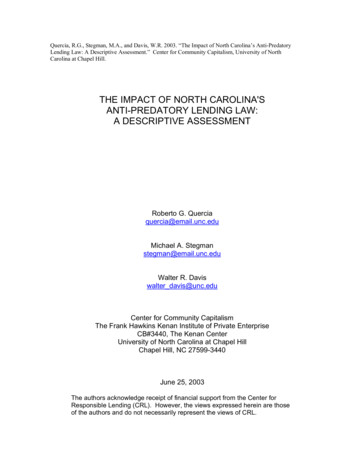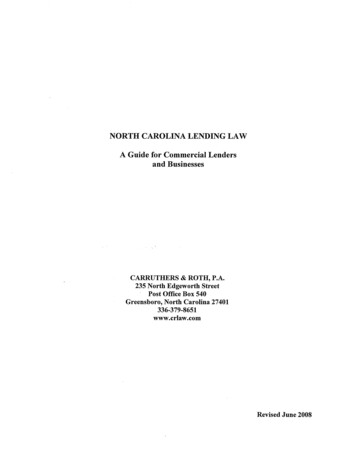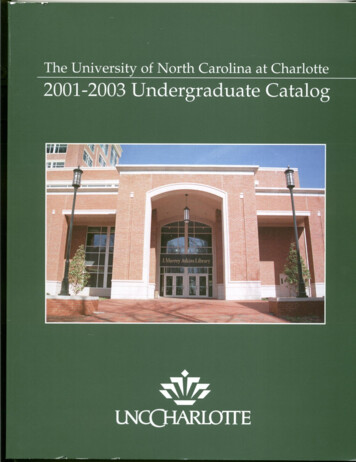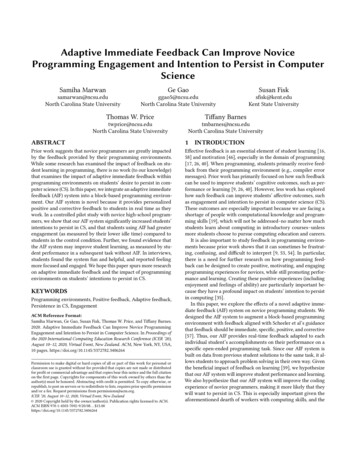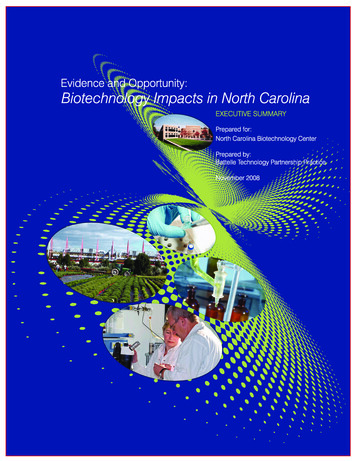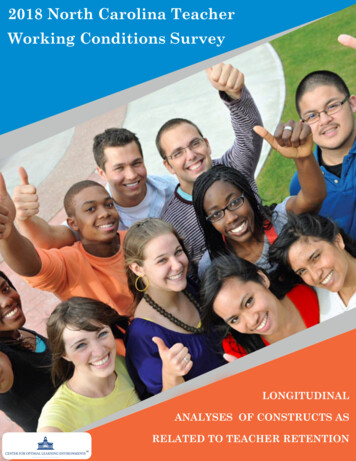
Transcription
2018 North Carolina TeacherWorking Conditions SurveyLONGITUDINALANALYSES OF CONSTRUCTS ASRELATED TO TEACHER RETENTION
2018 North Carolina Teacher Working ConditionsSurvey: Longitudinal Analyses of Constructs asRelated to Teacher Retention 2019 Center for Optimal Learning Environments All Rights Reserved.2
T A B L E OF C O N T ENTSINTRODUCTION . . . . . . . . . . . . . . . . . . . . . . . . . . . . . . . . . . . . . . . . . . 4CONSTRUCT AVERAGES OVER TIME . . . . . . . . . . . . . . . . . . . . . . . . 6INGERSOLL ELEMENTS AND CONSTRUCTS . . . . . . . . . . . . . . . . . . 7TEACHER RETENTION AND NCTWC SURVEY CONSTRUCTS. . . . . 8SCHOOL LEADERSHIP CONSTRUCT . . . . . . . . . . . . . . . . . . . . . . . . . . . . . . 9TIME CONSTRUCT. . . . . . . . . . . . . . . . . . . . . . . . . . . . . . . . . . . . . . . . . . . . . 12INSTRUCTIONAL PRACTICES AND SUPPORT CONSTRUCT. . . . . . . . . . 13MANAGING STUDENT CONDUCT CONSTRUCT. . . . . . . . . . . . . . . . . . . . . 15SUMMARY . . . . . . . . . . . . . . . . . . . . . . . . . . . . . . . . . . . . . . . . . . . . . . 17RECOMMENDATIONS . . . . . . . . . . . . . . . . . . . . . . . . . . . . . . . . . . . . . . . . . . 18 2019 Center for Optimal Learning Environments All Rights Reserved.3
I N TRO D U C T IONThe following analyses highlight key findings from the 2018 North Carolina Teacher WorkingConditions (NCTWC) Survey in relation to previous iterations of the survey. The Center forOptimal Learning Environments (COLE) has reviewed the data and determined certain areasthat may be of special importance to North Carolina education policy makers. These areas covermatters that include: greatest growth; greatest reductions; needed improvement; key issues; and/or student performance. For each topic, data charts are provided along with descriptions. All datawere provided to the COLE by the North Carolina Department of Public Instruction (NCDPI) inSpring 2019.Drawing from NCDPI information about the survey, some background on the NCTWC Survey ispresented here for historical context:“In 2006, Senate Bill 622 passed, establishing North Carolina Teacher Working ConditionsSurvey (NCTWCS) as permanent part of the budget. The NCTWCS provides valuable informationto the school, district, and state level by which policymakers can make informed, data-drivendecisions. The survey assesses whether educators across the state report having the resources andsupports necessary to ensure effective teaching.The results of the survey are one component of the on-going process for collaborative school anddistrict improvement plans. The survey results will also allow administrators to better understandthe working conditions data and to implement concrete short- and long-term reform strategiesto improve teacher working conditions and student learning conditions statewide. By improvingteacher working conditions, the recruitment and retention of quality professionals can be ensured,and higher student achievement will result.Data from previous surveys indicate a link between staff perceptions of teaching and learningconditions and student achievement as well as on decisions of teacher retention. 2019 Center for Optimal Learning Environments All Rights Reserved.4
The North Carolina School Executive Principal Evaluation Process manual refers to the surveyresults as a possible artifact as to the administrator’s effectiveness in executing professionalstandards. The biennial survey spawns hundreds of studies on how teaching conditions correlatewith recruitment, retention, student achievement, school grades, teaching strategies, etc.The North Carolina Department of Public Instruction and the North Carolina State Board ofEducation have made a sustained commitment to listening to educators and reforming schoolsto create the working conditions necessary for student and teacher success. With nine iterationsof the NCTWC Survey and over 109,000 respondents in 2018 (91 percent) to critical questionsabout their workplace, analyses have been consistent and clear: the conditions teachers face inschools and classrooms, though often overlooked, are essential elements to student achievementand teacher retention.”COLE selected the 2014, 2016 and 2018 survey years for the longitudinal analyses in this review.In each of these years, more than 100,000 educators in the state completed the voluntary survey.Most of the following data charts use the percentage of Rates of Agreement (RA) which is the sumof Strongly Agree and Agree, as the unit of measurement. 2019 Center for Optimal Learning Environments All Rights Reserved.5
CONSTRUCT AVERAGES OVER TIMEBased on the data provided by NCDPI, comparisons of the construct averages offer an overview ofthe trends in the wide-ranging constructs of the survey. See Figure 1.Figure 1. North Carolina Construct Averages Over Time 2014-2018From 2014 to 2018 the trends increased slightly for Facilities and Resources (1%), InstructionalPractices and Support (1%), Teacher Leadership ( 2%), School Leadership (1%), Use of Time (4%).Two constructs decreased in RA, with a slight decrease in Community Support and Involvement(-1%) and Professional Development (-1%) and a more notable decrease in Managing StudentConduct (-4%). 2019 Center for Optimal Learning Environments All Rights Reserved.6
I NGERSO LL EL E ME NTS A ND C ONS TRUC T SOne of the more recent and pertinent research reports connecting student achievement to teachingconditions survey questions was from the renowned Dr. Richard Ingersoll, Consortium for PolicyResearch in Education at the University of Pennsylvania. In late 2017, Ingersoll released ananalysis using almost one million responses, from across 16 states in the country, on a teachingand learning conditions survey, which had its origins in the state of North Carolina in 2002. Theresearch by Dr. Richard Ingersoll (as explained in COLE’s Brief to NCDPI: 2018 NC TeacherWorking Conditions Survey Results and Connection to Student Achievement and Teacher Retention:An Analysis of Key Findings for Policy Makers) lists five key leadership “elements”:School Leadership1. Teachers are held to high professional standards for delivering instruction.2. The faculty and leadership have a shared vision.3. The school improvement team provides effective leadership at this school.Teacher Decision-Making4. Teachers’ roles in establishing student discipline procedures.5. Teachers’ roles in planning school improvement.These elements are strongly connected to student achievement and correspond to the NCTWCSurvey questions in the School Leadership and Teacher Leadership constructs. His results providepolicy makers and leaders at the school and district levels a clear roadmap to making decisions.No longer must a school or district leader struggle to guess which exact issues will be the mostpertinent for them to tackle as they make their annual school improvement plans using the surveydata as required in statute. They can focus on the questions/answers associated with the fiveelements Dr. Ingersoll found to be the most strongly connected to student achievement and theimpact of teacher retention on that achievement.The balance of this document discusses the major constructs affecting teacher retention in NorthCarolina and how Ingersoll’s five key elements for education leadership can be used to assisteducation policy makers. 2019 Center for Optimal Learning Environments All Rights Reserved.7
T EAC HER R ET E NTIO N A N D N C T W CS URVEY C ONST RU C TSTeacher retention is a major factor when considering education policies. However, to bestunderstand what leads to retention issues it is important to understand the reasons teachersremain at their current school, not just remaining in teaching. This is important for two mainreasons. First, it is the movement of teachers from school to school which creates the “leakybucket” phenomenon about teacher recruitment and retention. A teacher “shortage” may not bethe true issue; rather it may be a revolving door of teachers moving from school to school thatcreates a shortage at given schools. Secondly, it matters to the students in the school what theactual school teacher turnover rate is. While statistics across the nation and in different statesoften give the numbers of teachers needed in a given year to fulfill the school rosters, what occursin a particular school affects its individual students.High teacher turnover can negatively impact the Ingersoll key elements needed for studentachievement. Imagine the difficulty of creating a shared vision, running an effective schoolimprovement team, involving teachers in the decisions around school improvement planningand developing student conduct policies in such a changing environment. (See the COLE Briefto NCDPI mentioned above for additional information on the relationship of teacher retentionand the Ingersoll research.) While the annual teacher turnover rate in North Carolina schools isapproximately 20% on average, closer examination reveals individual schools where the annualturnover rate exceeds 30-45% on a regular basis.COLE examined responses teachers selected from the construct most affecting their decision toremain teaching in their current school. The 2018 survey responses (Figure 2) are representativeof earlier years and provide a window into their decision to remain. 2019 Center for Optimal Learning Environments All Rights Reserved.8
Figure 2. Construct Which Most Affects Educator’s Willingness to Remain Teaching in Their Current School (2018)The following discussions highlight four of these constructs that 70% of teachers have stated arethose most influencing their reasons to remain teaching: SCHOOL LEADERSHIP (30%)Time (15%)Instructional Practices and Support (14%)Managing Student Conduct (11%)Because construct averages usually mask key identifiers that can help policy makers in theirdecision, it is important to consider the individual items in the construct to see what particularissues may be causing upward or downward trends. To assist policy makers, for each topic discussedthere is an analysis that delves into the responses to the construct questions and, additionally,provides some information on its relationship to the Ingersoll elements.SCHOOL LEADERSHIP CONSTRUCTSchool Leadership continues to be the major reason (at 30%) educators list as the constructwhich affects their willingness to remain teaching in their current school. Thirty percent of therespondents in 2018 (approximately 30,000 teachers) listed this as their answer. Recent researchby Dr. Richard Ingersoll (as explained in COLE’s Brief to NCDPI referenced above) supports theconsistency and percentage of answers indicating the construct of School Leadership is a significantfactor in why teachers wish to remain in their school.The School Leadership construct shows a rate of agreement increase by 1% from 2014 (84%) to2018 (85%). Analysis of the individual questions which make up the construct offers insight into thequalities of School Leadership that impact the decision to stay or leave teaching in their schools. 2019 Center for Optimal Learning Environments All Rights Reserved.9
Figure 3, below, shows the top ten reasons (not the construct) that impact the decision to stayor leaver teaching in the current school. Most of them mirror individual questions in the SchoolLeadership construct.In the area of teacher evaluation there are questions where the RA increased more than otherquestions: The procedures for teacher evaluation are consistent ( 3%); Teacher performance isassessed objectively ( 2%); Teachers receive feedback that can help them improve teaching ( 1%).Other aspects of School Leadership show a slight upward trend as well with the following questionsshowing increased RAs of 1%: There is an atmosphere of trust and mutual respect in this school;Teachers feel comfortable raising issues and concerns that are important to them; and the facultyare recognized for accomplishments.However, the three questions in this construct which, according to Ingersoll’s research have thestrongest connection to student achievement, are either holding steady with no growth, or show aslight downward trend: Teachers are held to high professional standards for delivering instruction(-1%); The school improvement team provides effective leadership at this school (no change); Thefaculty and staff have a shared vision (no change).Figure 3. Individual School Leadership Questions 2014-2018Please rate how strongly you agree or disagree withstatements about leadership in your school.2014 2018 DifferenceThere is an atmosphere of trust and mutual respect in this school.Teachers feel comfortable raising issues and concerns that areimportant to them.73%74%1%72%73%1%The school leadership consistently supports teachers.Teachers are held to high professional standards for deliveringinstruction.*The school leadership facilitates using data to improve studentlearning.80%79%0%94%93%-1%94%94%0%Teacher performance is assessed objectively.86%88%2%Teachers receive feedback that can help them improve teaching.85%86%1%The procedures for teacher evaluation are consistent.The school improvement team provides effective leadership at thisschool.*84%87%3%84%84%0%The faculty are recognized for accomplishments.85%86%1%The faculty and staff have a shared vision.*84%84%0%*Indicates the question is one of the three School Leadership questions which Dr. Ingersolldetermined were the highest connection to student achievement. (For more information on thisresearch, please visit http://optimallearningenvironments.com.) 2019 Center for Optimal Learning Environments All Rights Reserved.10
The construct of School Leadership and the individual three questions showing either a decreaseor no change in RAs may be of importance to policy makers because of the connection Dr. Ingersollmade to student achievement and School Leadership.Recommendations: Policy makers should further explore the teacher retention history of schools with low andhigh values for the construct of School Leadership, especially in the three elements of SchoolLeadership which Dr. Ingersoll found so strongly connected to student achievement:o Teachers are held to high professional standards for delivering instruction.o The faculty and leadership have a shared vision.o The school improvement team provides effective leadership at this school. Policy makers should focus efforts across the state to share the Ingersoll findings connectingstudent achievement to School Leadership. Since the three areas identified as having thestrongest connection to student achievement, are either holding steady with no growth, or aslight downward trend change, this trend is something that warrants attention. 2019 Center for Optimal Learning Environments All Rights Reserved.11
TIME CONSTRUCTWhile the Time construct average trends upwards from 65% (in 2014) to 69% (in 2018), someindividual items are noteworthy. Based on an analysis of the individual questions (Figure4), twoareas show the greatest increases over time. Both items are topics important to teachers and showa positive trend upward. Efforts are made to reduce routine paperwork (10% increase over four years) Teachers have sufficient time to meet the needs of all students (5% increase overfour years)Figure 4. Individual Items in the Time Construct: 2014-2018Please rate how strongly you agree or disagree withthe following statements about the use of time inyour school.20142018DifferenceClass sizes are reasonable such that teachers have thetime available to meet the needs of all students.60%60%0%Teachers have time available to collaborate with colleagues.73%75%2%Teachers are allowed to focus on educating studentswith minimal interruptions.67%69%2%The non-instructional time provided for teachers in myschool is sufficient.63%65%2%Efforts are made to minimize the amount of routinepaperwork teachers are required to do.57%67%10%Teachers have sufficient instructional time to meet theneeds of all students.66%71%5%Teachers are protected from duties that interfere withtheir essential role of educating students.71%73%2%As described earlier, Time was the second highest factor (at 15%) selected by respondents as thereason to remain teaching in their school. Thus, this construct plays a significant role in the teacherretention rate in North Carolina.Note: the use of time in a school is the responsibility of the elected School Improvement Team(SIT) in North Carolina. 2019 Center for Optimal Learning Environments All Rights Reserved.12
Recommendations: Policy makers should focus efforts across the state to identify what policies and actionsled to the positive upward trend in the Time construct and its components and share themacross state and district leaders. Policy makers should work with SIT to ensure that the School Leadership and TeacherLeadership roles highlighted in the Ingersoll findings are incorporated in the SIT effortsrelated to the Time construct.INSTRUCTIONAL PRACTICES AND SUPPORT CONSTRUCTFigure 5. Individual Items in the Instructional Planning and Support Construct: 2014-2018Please rate how strongly you agree or disagree with the followingstatements about instructional practices and support in your school.20142018DifferenceLocal assessment data are available in time to impact instructional practices.79%85%6%The curriculum taught in this school is aligned with theNorth Carolina Standard Course of Study.98%98%0%Teachers work in professional learning communities to develop and align instructional practices.91%92%1%Provided supports (i.e. instructional coaching, professionallearning communities, etc.) translate to improvements in instructional practices by teachers.87%87%0%Teachers are encouraged to try new things to improve instruction.93%93%0%Teachers are assigned classes that maximize their likelihoodof success with students.69%71%2%Teachers have autonomy to make decisions about instructional delivery (i.e. pacing, materials and pedagogy).80%83%3%Teachers believe almost every student has the potential to dowell on assignments.91%91%0%Teachers believe what is taught will make a difference instudents’ lives.93%94%1%Teachers require students to work hard.95%94%-1%Teachers collaborate to achieve consistency on how studentwork is assessed.88%88%0%Teachers know what students learn in each of their classes.85%84%-1%Teachers have knowledge of the content covered and instructional methods used by other teachers at this school.84%83%-1%Teachers use digital content and resources in their instruction.N/A96%Teachers use assessment data to inform their instruction.93%96% 2019 Center for Optimal Learning Environments All Rights Reserved.N/A3%13
For the most part, the questions which compose the construct of Instructional Practices andSupport showed little to no change ( /- 1%) from 2014-2018. There are three questions whichshow a positive trend beyond the 1% difference: Local assessment data are available in time toimpact instructional practices (6%); Teachers have autonomy to make decisions about instructionaldelivery (3%); and Teachers are assigned classes that maximize their likelihood of success withstudents (2%).With 14% of the state’s respondents saying this construct is the main reason they are selecting tostay teaching, it is worth looking a little deeper at what is being said in this positive trend of theidentified questions. Teachers are saying they are getting local assessment data in time so theycan use it to improve instruction. With roughly the same overall number of respondents to eachsurvey in 2014 and 2018, and with the percentages holding stable on the selection of this constructas the reason they wish to remain teaching, that means approximately 6,000 more teachers in2018 agree with this condition than in 2014. Applying the same reasoning, 3,000 more teachersstated they have autonomy to make decisions about their delivery of instruction, and 2000 moreteachers said they are assigned classes which maximize their likelihood of success with students,i.e., assigned classes in their field of licensure, grade level, or expertise.Instructional Practices and Support was the third highest factor (at 14%) selected by respondentsas the reason to remain teaching in their school. Thus, this construct plays a significant role inthe teacher retention rate in North Carolina. While Instructional Practices and Support is notexplicitly addressed in the Ingersoll report, the construct’s role in teacher retention and its relatedimpact on student achievement cannot be ignored.Recommendations: Policy makers may wish to look closely at the 2020 NCTWC survey results and determine ifthere are geographical or regional patterns to each of the three questions which showed thegreatest increase in Rates of Agreement. Further analyses may provide excellent examples of best practices being used in schools ordistricts which can be shared with leaders across the state. 2019 Center for Optimal Learning Environments All Rights Reserved.14
MANAGING STUDENT CONDUCT CONSTRUCTCloser examination of the individual survey questions which make up the construct ManagingStudent Conduct shows a downward trend for each question.The question with the greatest drop since 2014 is “Students at this schools follow rules of conduct”showing a decrease in RA from 72% to 65%. That means in 2018 approximately 38,000 educatorsacross the state are saying this statement is false! (seven thousand more than in 2014).Figure 6. Individual Items in the Managing Student Conduct Construct: 2014-2018Please rate how strongly you agree or disagree with the following statements about managing student conduct in your school.20142018DifferenceStudents at this school understand expectations for their conduct.85%82%-3%Students at this school follow rules of conduct.72%65%-7%Policies and procedures about student conduct are clearly understood by the faculty.84%81%-3%School administrators consistently enforce rules for studentconduct.72%69%-4%School administrators support teachers’ efforts to maintain discipline in the classroom.82%79%-3%Teachers consistently enforce rules for student conduct.81%77%-2%The faculty work in a school environment that is safe.93%89%-4%Many of the questions in this construct are directly or indirectly related to school leadership. Theseinclude: School administrators consistently enforce rules for student conductStudents at this school understand expectations for their conductThe faculty work in a school environment that is safe. (This question shows thatapproximately 11,000 teachers are telling state leaders they are currently workingin schools they deem unsafe!)COLE’s analysis of the 2018 NCTWC data showed only 63% of the 2018 respondents agreed thatteachers are involved in developing the policies for establishing student discipline procedures asimilar number to the overall agreement to students following rules of conduct (65%). Researchby Dr. Richard Ingersoll (as explained in the COLE Brief to NCDPI referenced above) makes adirect connection between student achievement and the role of teachers being involved in the 2019 Center for Optimal Learning Environments All Rights Reserved.15
development of policies around managing student conduct.With approximately 11,000 teachers stating the main construct which determines whether theystay in teaching is Managing Student Conduct, this is an area which needs closer attention bypolicy makers for many reasons:1. The safety of students and educators in the schools2. The connection of this construct to teacher retention3. The connection in Ingersoll’s findings on student achievement and the role ofteachers in the development of school discipline policies.RECOMMENDATIONS: Policy makers in North Carolina should share strategies that help leaders increase theinvolvement of educators in formulating student discipline procedures. The strategies should document the link in the recent Ingersoll research betweenstudent achievement and teacher decision making, policy makers in North Carolina. After the 2020 NCTWC survey results are collected, policy makers should analyze theresults to determine: Any regional or geographic trends to the question on school safetyIf specific questions in the Managing Student Conduct construct relate toIngersoll’s finding connecting the role of teachers in the development of studentdiscipline policies, especially as the policies impact the understanding by studentsof expectations for their conduct and following rules of conduct. Policy makers should consider implementing a student and parent survey to furtherunderstand what is happening in the schools where the Managing Student Conduct constructhas considerably lower RAs than the rest of the state. 2019 Center for Optimal Learning Environments All Rights Reserved.16
S UMMARYCOLE analyzed findings of the North Carolina Teacher Working Conditions Survey resultssince 2014 to highlight key items of interest. The construct averages showed trends for the threeiterations of the survey which are generally positive. Five of the eight constructs of the survey from2014 to 2018 increased in Rate of Agreement: Time, Facilities and Resources, Teacher Leadership,Professional Development, and Instructional Practices and Support. Two of the eight constructsremained either steady or slightly improved: School Leadership, and Community Support andInvolvement. Only one of the eight constructs, Managing Student Conduct, decreased since 2014(81% in 2014 to 77% in 2018).Four of the constructs were selected for further analysis because they were the constructs whichapproximately 70,000 educators in each of the last three interactions of the survey stated wasthe main reason they are selecting to remain in teaching: School Leadership, Time, InstructionalPractices and Support, and Managing Student ConductA closer look at some of the constructs revealed areas which may be of particular interest topolicy makers. One such area is the questions included in the Managing Student Conduct. Everyquestion in the construct showed a decrease in the rates of agreement since 2014. This should be ofparticular importance to policy makers for three reasons: (1) the school safety concerns in today’sworld; (2) the connection Dr. Ingersoll’s research makes between student achievement and the roleof teachers being involved in the development of policies around managing student conduct; and(3) the impact on teacher retention. 2019 Center for Optimal Learning Environments All Rights Reserved.17
RecommendationsNorth Carolina statute clearly lays out the roles and authorities of each School ImprovementTeam. Included are many of the aspects of teaching conditions brought to light in this documentwhich are connected to student achievement and teacher retention, including the authority todevelop the school budget and priorities, the schedule for teachers, and the school student conductpolicies. The State should provide training for school leaders so that they can focus on the efficientuse of their School Improvement Teams. The State should use the results of the 2020 NCTWC survey to identify schools and districtswhich are exemplars in the five elements Dr. Ingersoll found to be most strongly connectedto student achievement and to teacher retention. The strategies and processes in these exemplar schools should then be sharedacross the state.A series of mentor/mentee teams should be established so that higherperforming schools can assist those who may be struggling in one or moreareas. 2019 Center for Optimal Learning Environments All Rights Reserved.18
www.optimallearningenvironments.com 2019 Center for Optimal Learning Environments All Rights Reserved.19
the working conditions data and to implement concrete short- and long-term reform strategies to improve teacher working conditions and student learning conditions statewide. By improving teacher working conditions, the recruitment and retention of quality professionals can be ensured, and higher student achievement will result.
